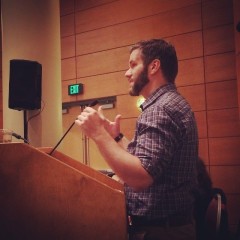How I Taught Then, How I Teach Now
Last April, I was on an AWP panel moderated by Joseph Scapellato which included Matt Bell, Jennine Capo Crucet, Derek Palacio, and moi. The title was “How I Taught Then, How I Teach Now,” a subject that is near and dear to my heart.
Description:

When experience forces us to challenge the assumptions that underpin our teaching philosophies, how do we sensibly revise our syllabi, course element by course element? In this panel, five teachers of writing share what they grew into knowing. They will describe how an active awareness of their changing assumptions changed their courses for the better. Practical before-and-after examples of course materials promise to make this panel useful for beginners and veterans alike.
Topics covered:
- Matt talks about what he calls “the privilege of early access,” a way of framing workshop discussion.
- Jeannine had some great suggestions for teaching students how to better analyze craft.
- I talked about helping students to develop a writerly identity.
- Derek describes a semester-long reading/craft project using Prezi.
- Joseph read a great and hilarious essay called “Respect.”
Many thanks to the folks at AWP for turning our conversations into this podcast.
I actually ran out of time and didn’t get to talk about all the items on my list, so here it is.
How to Help Students Feel like “Real Writers”
These days, I’m less interested in teaching students “to write” and more interested in giving them the chance to feel like “real writers.”
That means helping them to:
1.) form an identity as a writer (or realize that no, they don’t want to “be” writers)
2.) take the next step in their career (toward a writer’s life or toward a writing-related career)
Story about when that moment happened for me:
I can tell you exactly the moments in my life in which I felt like a real writer. Most of them happened at the desk, from the inside out, but one happened when I got my first full-time teaching position at Minnesota State University Mankato.
My mentor Rick Robbins was helping me with my taxes, and he said, “You should file a Schedule C. Profit or Loss from a Business.”
“What business?” I said.
“Your writing,” he said. “You’re like a small business owner, really.”
That’s the day I realized that, in addition to being a college professor, I was the owner of a small business called Being the Writer Cathy Day.
Another example: It’s become common practice in creative writing classes to require students to submit work to a real literary magazine. These are the kinds of active learning assignments I like to use in order for my students to feel like “real writers.”
Here are some other ways:
Help them join a community writers and readers. Change what they see when they look at FB and Twitter.
- If there’s a class you teach regularly, create a group on FB and require them to join. Or create a hashtag on Twitter and require that they use it.
- They will meet each other and former students, even alumni.
- These groups have become communities in which I can easily share advice and opportunities. They are places where we continue discussions we can’t finish in class.
- Changing what they see on Facebook or Twitter helps them to see themselves differently.
Show them that writing isn’t “homework” and social media isn’t “private.”
Show them how to buy a domain name and/or start a blog. WordPress. Tumblr. Whatever. Because there’s something about becoming “Google-able” that’s important to identity creation in a networked age.
Use Google Docs in your class rather than Blackboard—because Blackboard is “school” and Google Docs is not.
Require them to create a professional email address such as cathyday@gmail.com instead of their edu address and instead of their first email address, which was probably something like ColtsFan287@yahoo.com or OneDirection4Ever@me.com.
Make them sign up for your Google Docs folder with that email address.
Have them use this new email address to sign up for their blog and create (if necessary) new Twitter accounts as well as LinkedIn, etc.
Show them how to transition to a more professional use of social media. Give them a few writers to follow who you think do it well.
Dedicate one of your classes (intro, intermediate, advanced) to helping students develop a regular writing regimen. In most classes, we put the most points at the end, in the portfolio. We assess the work that’s been revised and revised. Try this instead: require students to write 2 or 3 thousand words a week—of any quality. Put the most number of points in your course into the process, not the product.
Teach your students not just how to submit to literary magazines but to agents and editors as well. That’s something we almost never talk about in creative writing classes–not at the undergraduate level, and not even at the graduate level. So what if they aren’t ready for it? Someday they might be. And even if they don’t ever publish a book, they will be more informed readers when they understand the process a book goes through from artist to reader.
Teach your students how to pitch their novels. Every week when my students turn in their words, they have to preface them with a logline—one or two sentences that describe the story’s premise, like a film description in TV Guide: When BLANK happens to BLANK, s/he must BLANK or face BLANK. Or something like that. I look at their words, but I give feedback each week on those loglines.
Have your students write the jacket copy of their own novel or someone else’s. It’s very hard to synopsize a whole novel, yes, but it’s also like a scale model of the larger architecture of the novel. Summarizing can teach them a great deal about what’s going wrong and right in the novel as a whole.
Now that they have logline and jacket copy, they have what they need to write a letter to an agent. This is where I try to use a cross-class assignment.
- Class A studies Agent Profiles online. They create a faux agent profile with photograph, bio, and the types of books they’re looking for.
- Class B (the novel class) studies these profiles and submits their manuscript to the appropriate agents.
- Class A receives vets their manuscripts and corresponds with Class B via rejection or acceptance letters.
My novel-writing class is the most unorthodox class I’ve ever taught. And the most popular. My evaluations are always positive, even though it’s the class in which I spend the LEAST time responding to their writing on the sentence level. – an example of how using the “privilege of early access,” Matt’s term, can lead to interesting learning outcomes.
The biggest difference between how I taught then and how I teach now is that the more I get out of the way and let my class be like a club, the happier my students are. And this astounds me, because I grew up learning in an entirely different way.
Final Note:
Some of you know that I’m on sabbatical this semester. I deactivated my FB and Twitter in November, but I reactivate them every 2-3 weeks just to check in, see my nieces and nephews, and deactivate again. But I wanted to come up for air today because I saw that this AWP podcast was up and wanted to share it with you!
I’m sorry that I haven’t been blogging a lot for the last few months. I started a blog post about why that is, but then I didn’t finish it. 🙂 Suffice it to say that I will be back soon, and I appreciate your patience. I’m on Instagram (I find that it doesn’t devour as much time because it’s not conversation oriented) and you can always reach me via email.
Teaching
One comment
Comments are closed.